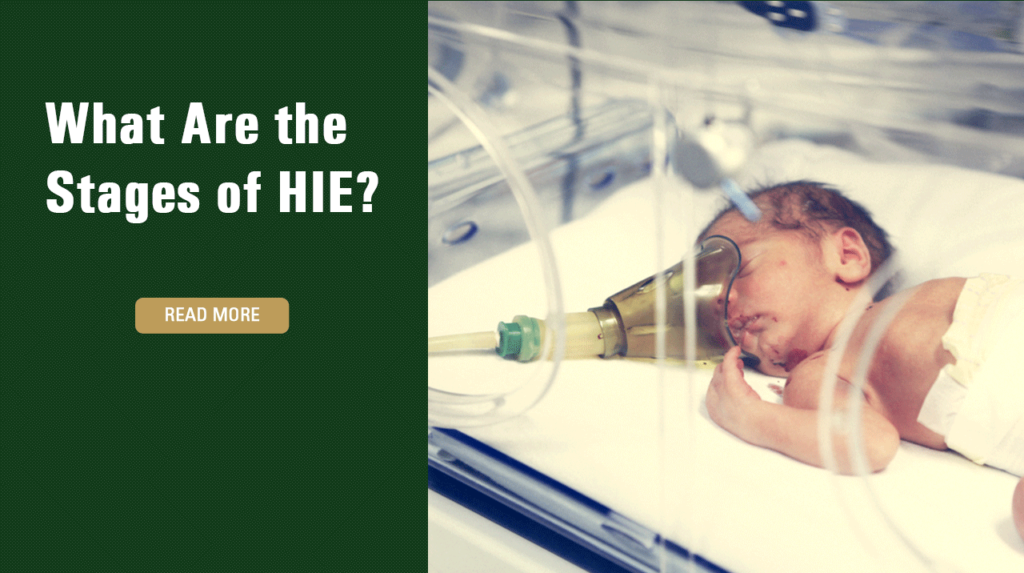What Are The Stages Of HIE?

A serious type of birth injury known as hypoxic-ischemic encephalopathy (HIE), occurs when the oxygen supply to the baby’s brain is cut off, which can cause damage. Brain injuries from HIE can happen during pregnancy and delivery, and they can be mild and temporary or severe and permanent. In some cases, HIE will result in the death of the baby when the baby’s oxygen deprivation lasts too long. Hypoxia refers to insufficient oxygen to a specific area of the body. Ischemia refers to when a body party is not getting enough blood flow, and encephalopathy refers to brain damage or disease. When something during pregnancy or childbirth prevents the fetus from getting enough oxygen to the brain, permanent damage can result when the lack of oxygen lasted for too long. A birth trauma attorney can work with a medical expert to help determine whether your child’s HIE was caused by medical malpractice.
What Is HIE?
HIE is a brain injury in newborns that results when their brains are deprived of oxygen and a sufficient blood supply. It is a birth injury because it occurs during birth or near birth. HIE is also known as birth asphyxia or neonatal encephalopathy. If medical professionals promptly identify the signs of fetal distress and intervene, brain damage might be averted. Therapeutic hypothermia might also be used within hours of a baby’s birth to minimize or prevent permanent brain damage caused by oxygen deprivation. In some cases, babies with HIE will develop permanent conditions, including cerebral palsy, epilepsy, cognitive disabilities, visual impairments, and more.
The severity of damage caused by HIE is typically not immediately apparent. This is because a brain injury caused by HIE evolves with time. When the flow of blood to parts of the brain is disrupted, the brain cells start to break down and die. When they do, they release toxins that cause damage to other cells. Those cells then start to die and release toxins, causing a chain reaction through which a brain injury can spread over several hours or days. Therapeutic hypothermia can disrupt the chain reaction and minimize damage.
In some cases, brain damage from HIE might not be recognized until a child is diagnosed with developmental delays. For example, parents and medical professionals might not recognize that a child’s mobility has been impacted until the child fails to meet developmental milestones such as crawling, rolling over, lifting his or her head, or walking. When permanent damage to the brain occurs, HIE cannot be cured. However, some therapies and treatments can address the symptoms and improve the child’s functioning.

The Stages Of HIE
A clinical ranking system was developed by two researchers who published their findings in 1976. This ranking system is used to help with the diagnosis of HIE. The doctors developed a system of classification for HIE in three stages.
Children with Stage 1 HIE have mild conditions. Those with Stage 2 HIE have moderate to severe conditions. Those in Stage 3 have severe conditions.
Symtpoms Of Stage 1 HIE
In children with mild HIE, the symptoms that might appear immediately after birth include the following:
- Slightly floppy muscle tone
- Hyper-alertness
- Brisk tendon reflexes
- Frequent crying
- Fussiness
- Trouble feeding
- Trouble sleeping
In many cases, these symptoms will subside within 24 hours of the baby’s birth. However, the baby should still be carefully monitored and receive appropriate treatment.
Symptoms Of Stage 2 HIE
An infant diagnosed with moderate to severe HIE might show the following symptoms:
- Noticeable and significant hypotonia
- Lower tendon reflexes
- Unusual lethargy
- Moro reflex
- Trouble grasping with the hands
- Lack of interest in suckling
- Trouble breathing
- Seizures
Children with moderate to severe HIE must be properly monitored and effectively treated. When a child receives effective medical care during the first several weeks of life, it can significantly improve the baby’s prognosis. The first few weeks after birth are the most critical for treating children diagnosed with state 2 HIE.
Stage 3 HIE Symptoms
In children with severe HIE, the symptoms you might notice include the following:
- Unresponsiveness
- Lack of response to physical stimuli
- Extreme trouble with breathing
- Hypotonia over the entire body
- Depressed reflexes
- Lack of neonatal reflexes, including Moro reflex, grasping, swallowing, and suckling)
- Visual problems
- Unresponsive, fixed, or dilated pupils
- Delayed seizures that increase after 24 to 48 hours and are treatment-resistant
- Irregular heartbeat
- Blood pressure problems
Proper monitoring and treatment of all cases of HIE are critical for improving the conditions. Severe HIE can cause permanent brain injuries or death. Medical providers must carefully monitor the baby’s symptoms as they appear and be prepared to respond to HIE symptoms immediately. If HIE is suspected, a doctor might order testing such as magnetic resonance imaging (MRI) to identify any damaged brain cells.
When doctors intervene within the first few hours, days, and weeks following a baby’s birth, their intervention can significantly improve the infant’s prognosis. Babies with HIE might receive treatment in a neonatal intensive care unit (NICU), which can help to avoid potential complications, improve the infant’s condition, and minimize other injuries that could result.
Talk To A Child Injury Lawyer
If your baby was diagnosed with HIE following birth and has developed other conditions as a result, you likely feel devastated and concerned about your child’s future. If your child’s condition was caused by the medical negligence of a healthcare professional, you might be entitled to pursue compensation for both your losses and those of your child. The attorneys at Raynes & Lawn can review what happened and provide you with a fair assessment of your claim’s merits. Call us at 1-800-535-1797 to schedule a free case evaluation.

For the general public: This Blog/Website is made available by the law firm publisher, Raynes & Lawn, for educational purposes. It provides general information and a general understanding of the law but does not provide specific legal advice. By using this site, commenting on posts, or sending inquiries through the site or contact email, you confirm that there is no attorney-client relationship between you and the Blog/Website publisher. The Blog/Website should not be used as a substitute for competent legal advice from a licensed attorney in your jurisdiction.
For attorneys: This Blog/Website is informational in nature and is not a substitute for legal research or a consultation on specific matters pertaining to your clients. Due to the dynamic nature of legal doctrines, what might be accurate one day may be inaccurate the next. As such, the contents of this blog must not be relied upon as a basis for arguments to a court or for your advice to clients without, again, further research or a consultation with our professionals.
